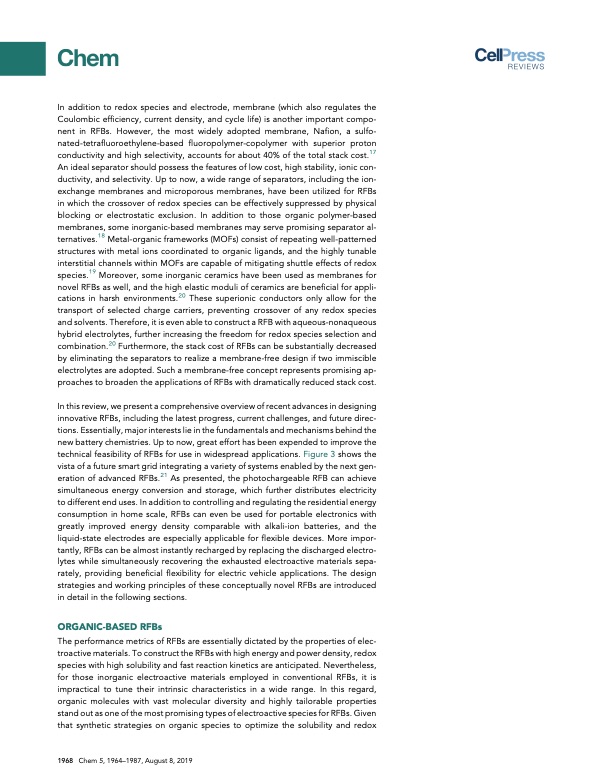
PDF Publication Title:
Text from PDF Page: 005
In addition to redox species and electrode, membrane (which also regulates the Coulombic efficiency, current density, and cycle life) is another important compo- nent in RFBs. However, the most widely adopted membrane, Nafion, a sulfo- nated-tetrafluoroethylene-based fluoropolymer-copolymer with superior proton conductivity and high selectivity, accounts for about 40% of the total stack cost.17 An ideal separator should possess the features of low cost, high stability, ionic con- ductivity, and selectivity. Up to now, a wide range of separators, including the ion- exchange membranes and microporous membranes, have been utilized for RFBs in which the crossover of redox species can be effectively suppressed by physical blocking or electrostatic exclusion. In addition to those organic polymer-based membranes, some inorganic-based membranes may serve promising separator al- ternatives.18 Metal-organic frameworks (MOFs) consist of repeating well-patterned structures with metal ions coordinated to organic ligands, and the highly tunable interstitial channels within MOFs are capable of mitigating shuttle effects of redox species.19 Moreover, some inorganic ceramics have been used as membranes for novel RFBs as well, and the high elastic moduli of ceramics are beneficial for appli- cations in harsh environments.20 These superionic conductors only allow for the transport of selected charge carriers, preventing crossover of any redox species and solvents. Therefore, it is even able to construct a RFB with aqueous-nonaqueous hybrid electrolytes, further increasing the freedom for redox species selection and combination.20 Furthermore, the stack cost of RFBs can be substantially decreased by eliminating the separators to realize a membrane-free design if two immiscible electrolytes are adopted. Such a membrane-free concept represents promising ap- proaches to broaden the applications of RFBs with dramatically reduced stack cost. In this review, we present a comprehensive overview of recent advances in designing innovative RFBs, including the latest progress, current challenges, and future direc- tions. Essentially, major interests lie in the fundamentals and mechanisms behind the new battery chemistries. Up to now, great effort has been expended to improve the technical feasibility of RFBs for use in widespread applications. Figure 3 shows the vista of a future smart grid integrating a variety of systems enabled by the next gen- eration of advanced RFBs.21 As presented, the photochargeable RFB can achieve simultaneous energy conversion and storage, which further distributes electricity to different end uses. In addition to controlling and regulating the residential energy consumption in home scale, RFBs can even be used for portable electronics with greatly improved energy density comparable with alkali-ion batteries, and the liquid-state electrodes are especially applicable for flexible devices. More impor- tantly, RFBs can be almost instantly recharged by replacing the discharged electro- lytes while simultaneously recovering the exhausted electroactive materials sepa- rately, providing beneficial flexibility for electric vehicle applications. The design strategies and working principles of these conceptually novel RFBs are introduced in detail in the following sections. ORGANIC-BASED RFBs The performance metrics of RFBs are essentially dictated by the properties of elec- troactive materials. To construct the RFBs with high energy and power density, redox species with high solubility and fast reaction kinetics are anticipated. Nevertheless, for those inorganic electroactive materials employed in conventional RFBs, it is impractical to tune their intrinsic characteristics in a wide range. In this regard, organic molecules with vast molecular diversity and highly tailorable properties stand out as one of the most promising types of electroactive species for RFBs. Given that synthetic strategies on organic species to optimize the solubility and redox 1968 Chem 5, 1964–1987, August 8, 2019PDF Image | Development of Redox Flow Batteries Based on New Chemistries

PDF Search Title:
Development of Redox Flow Batteries Based on New ChemistriesOriginal File Name Searched:
PIIS2451929419302207.pdfDIY PDF Search: Google It | Yahoo | Bing
Salgenx Redox Flow Battery Technology: Salt water flow battery technology with low cost and great energy density that can be used for power storage and thermal storage. Let us de-risk your production using our license. Our aqueous flow battery is less cost than Tesla Megapack and available faster. Redox flow battery. No membrane needed like with Vanadium, or Bromine. Salgenx flow battery
| CONTACT TEL: 608-238-6001 Email: greg@salgenx.com | RSS | AMP |